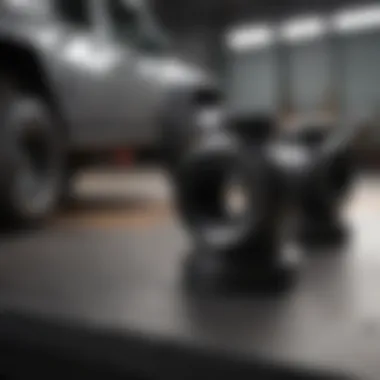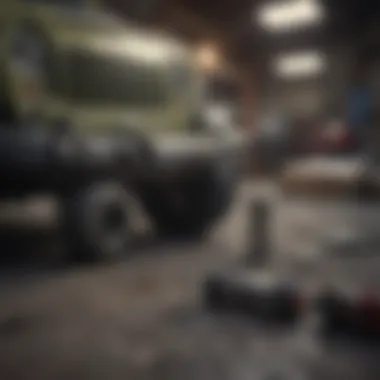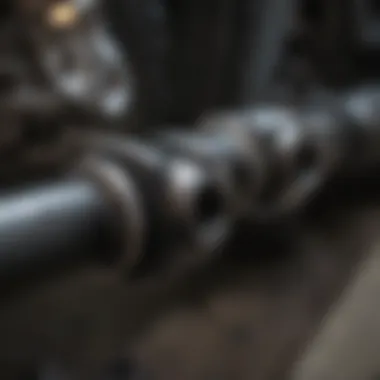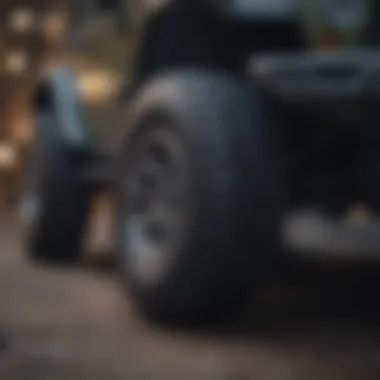Comprehensive Guide to Jeep Wrangler Control Arm Bushings


Intro
Replacing control arm bushings in a Jeep Wrangler is a crucial maintenance task that can greatly affect the vehicle's handling and performance. The control arm bushings serve as connectors between the control arms and the vehicle's frame. Over time, these bushings can wear out, which leads to various handling problems and a less comfortable driving experience. This article aims to educate Wrangler owners on the importance of these components, the symptoms that indicate they need replacement, and provide a step-by-step guide to the replacement process itself.
Automotive Features and Innovations
In today's automotive landscape, the Jeep Wrangler has undergone significant transformations. The introduction of advanced features enhances both functionality and user experience. Although the focus here lies specifically on mechanical components, it's essential to acknowledge innovative practices in the automotive industry that could impact vehicle maintenance, including control arm bushings.
Overview of Latest Technologies
Newer Jeep Wranglers come equipped with complex systems to improve off-road capability and comfort. The integration of better suspension design and materials promotes optimal performance even in rough terrains. It is worthwhile for Jeep owners to stay informed about these developments as it reflects directly on maintenance decisions, including engagement with OEM or aftermarket bushings.
Maintenance Tips and Best Practices
When it comes to caring for your Jeep Wrangler, understanding regular maintenance schedules is vital.
- Regular Inspections: Check for signs of wear regularly. Look for cracks, tears, or any visible deformities.
- Replacement Frequency: While many recommend changing control arm bushings every few years, it also hinges on how the vehicle is used. Off-road enthusiasts might need replacements more frequently.
For Jeep Wrangler owners venturing into DIY repairs, detailed guides on carrying out tasks like bushing replacement can be especially useful. A clear understanding of the proper tools necessary for such projects minimizes chances of mistakes.
Routine bushing checks extend the life of the control arms and improve handling on and off-road.
Conventional Wisdom in Bushing Selection
Another important consideration lies in whether to opt for Original Equipment Manufacturer (OEM) parts or aftermarket alternatives. Generally, OEM parts guarantee compatibility and reliability. Alternatively, aftermarket parts can be cost-effective and offer different performance characteristics. Owners should evaluate the pros and cons based on their driving needs and budgets.
Epilogue
The replacement of control arm bushings in Jeep Wranglers not only enhances operational efficiency, it significantly contributes to safer driving experiences. It is a worthy investment that every Jeep owner should take seriously. Whether a novice or expert mechanic, understanding this essential aspect of your Jeep contributes to a more resilient and dependable vehicle.
Preamble to Control Arm Bushings
Control arm bushings are crucial components in a Jeep Wrangler's suspension system. Their main jobs include connecting the control arms to the vehicle's frame and allowing for controlled movement. This section sheds light on their definition, functions, and their undeniable importance to the overall performance of the vehicle.
Definition and Function
In simple terms, control arm bushings are cylindrical rubbers or polyurethanes that act as a cushion between the suspension components. They usually sit at both ends of the control arm, helping to manage the dynamic motions that occur when driving. This design allows for some flexibility while maintaining tight coupling. When the wheels go over bumps or uneven ground, the bushings absorb the shock, uplifting both comfort and control for occupants.
One major characteristic to note about these bushings is that they provide a degree of damping. This is essentially how well they manage differential movements between the parts of the suspension. Over time, these components endure wear, dirt, and heat, leading to tears or deterioration. Knowing their function clarifies why monitoring their condition is essential for any vehicle, particularly off-road variants like the Wrangler.
Importance in Vehicle Dynamics
Control arm bushings hold significant sway over a Jeep Wrangler's vehicle dynamics. They directly influence many critical aspects of the vehicle's operation, such as steering response, tire wear, and suspension geometry.
- Steering Responsiveness: When control arm bushings age or become wornout, they start losing their ability to keep the suspension taut. This deterioration affects the vehicle's steering precision. A Jeep overall loses the connected feel with the road, making driving less engaging.
- Tire Wear Patterns: Worn-out bushings may prompt uneven tire wear. More stress gets placed on certain tires, leading to a biased degradation over time. This not only requires more frequent tire replacements, it also impacts traction, especially during sharp maneuvers.
- Suspension Geometry: Control bushing position consistently aligns the control arms, thereby preserving optimal suspension angle through various conditions. Misalignment affects handling and can lead to undesirable understeer or oversteer.
Overlooking the importance of control arm bushings can lead to performance issues down the line. Therefore, understanding their functionality is imperative for anyone aiming to enhance their Jeep’s ride quality and raw performance.
It is essential for Jeep owners to periodically inspect control arm bushings to ensure the vehicle maintains its performance and safety criteria. Letting issues go unchecked might escalate into more serious suspension problems.


Identifying the Need for Replacement
Knowing when to replace control arm bushings is essential for maintaining the Jeep Wrangler's performance and safety. Control arm bushings, small yet vital components, absorb shocks and allow for controlled suspension movement. Over time, these bushings can wear out or degrade, which can lead to various detrimental effects on the vehicle. Hence, understanding the signals that indicate a need for replacement is crucial for every Jeep owner.
Common Signs of Worn Bushings
Identifying worn bushings is not always straightforward, and subtle symptoms may often indicate more significant underlying issues. Some common signs include:
- Unusual noises: If you hear clunking or rattling sounds while driving, particularly over bumps, it may indicate that your control arm bushings are worn.
- Poor alignment: If you notice your steering wheel pulling to one side or abnormal tire wear, worn bushings could be affecting your suspension geometry.
- Increased vibration: A harsh ride, particularly on uneven surfaces, might signal problems with the bushings that are supposed to absorb vibrations.
Recognizing these symptoms early can save time and money. Ignoring them might lead to additional wear on suspension components and more extensive repairs.
Impact on Vehicle Performance
The control arm bushings directly influence vehicle handling and comfort. Their primary role is to isolate vibrations and noise while maintaining the alignment of various suspension parts. When these bushings fail, the impact on overall performance can be significant, leading to:
- Deteriorated handling: Worn bushings compromise steering precision. This deterioration affects cornering stability and may make the vehicle feel vague or unresponsive.
- Uneven tire wear: Improper alignment as a result of faulty bushings can cause tires to wear unevenly, leading to costly replacements.
- Reduced ride quality: As control arm bushings wear out, the vehicle's ability to absorb bumps diminishes, resulting in a harsher and less comfortable driving experience.
Maintaining optimal performance involves promptly addressing any bushing wear.
Visual Inspection Techniques
Visual inspections are a practical way to identify the condition of your control arm bushings. Some efficient techniques include:
- Look for cracks or tears: Examine the bushings for any visible damage. Signs of cracking or deterioration can help you determine if replacement is needed.
- Check for discoloration: Light discoloration may suggest the rubber has aged and lost its effective properties, which could affect performance.
- Monitor movement: Wiggle or move the control arm; excessive looseness may suggest that the bushings have lost their shape or become ineffective.
Always inspect both sides of the vehicle to ensure a comprehensive assessment. Scheduling regular inspections can prevent larger issues from developing in the future.
It is imperative to monitor these signs actively to avoid compromised vehicle performance and safety. Regular attention to these factors can prolong the lifespan of your Jeep Wrangler's suspension components.
Tools Required for Replacement
When it comes to replacing control arm bushings in your Jeep Wrangler, having the right tools can make all the difference between a straightforward process and a frustrating experience. Proper tools enable a safer and more efficient job, ensuring both you and your vehicle are well maintained.
Essential Tools
To embark on this task, ensure you gather the following essential tools:
- Socket Set: A good socket set is crucial to removing various bolts around the control arm successfully.
- Wrench Set: A comprehensive wrench set will help in loosening tight fasteners. Consider both metric and standard sizes.
- Pry Bar: A pry bar is helpful for maneuvering stubborn bushings without damaging surrounding components.
- Torque Wrench: This tool ensures that all bolts are tightened to the recommended specifications, which is vital for safety when you drive again.
- Bushing Tool: Specialized bushing removal/install tools can make it significantly easier to replace old bushings without applying too much leverage, which could potentially harm other parts.
Ultimately, these tools collectively facilitate a smooth replacement experience, ensuring the old bushings can be removed efficiently, and new ones can be installed with precision.
Safety Equipment
Safety should never be overlooked when doing automotive repairs. It is essential to prioritize your well-being throughout this process to minimize risks and injuries.
Key safety equipment includes:
- Safety Glasses: Protect your eyes from debris. Working with vehicles can generate dust or particles.
- Gloves: Use oil-resistant gloves to protect your hands, especially when handling materials that can be rough or covered in fluids.
- Knee Pads: Consider padded knee protection. Prolonged kneeling while working under a vehicle can cause discomfort.
- Jack Stands: Never rely solely on a hydraulic jack to support the vehicle. Jack stands provide secure and reliable support when you are under the vehicle.


Investing in proper safety equipment elevates the overall security of your workspace, ensuring you can focus on the task at hand, free of unnecessary hazards.
Safety is not an option; It is a necessity! Always be cautious.
Step-by-Step Replacement Process
The process of replacing control arm bushings is critical, not only for the agility of your Jeep Wrangler but also ensuring its overall safety and effectiveness on the road. The control arm bushings play a significant role in maintaining the alignment and stability of the vehicle. This segment details the effective steps necessary for performing this replacement.
Preparation and Safety Measures
Before initiating this task, preparation is paramount. First, choose a workspace that is clean and well-lit, allowing for unhindered movement and visibility. Gather the tools needed to perform the replacement, including a jack, socket set, torques wrench, and possibly a bushing press. Having everything in one place decreases the likelihood of interruptions.
Safety measures cannot be overlooked. Always wear protective gloves and eyewear to safeguard against possible debris or sudden movement of tools. Make sure the vehicle is on a flat surface and deploy wheel chocks to block the wheels. Hy-billionimpact may occur if proper safety steps are not taken.
Removing the Old Bushings
Once you are set up and safe, begin with the actual removal process. Start by securely raising the Jeep using a jack and supporting it with jack stands. Next, locate the control arms and identify the bushings you wish to replace. Loosen the bolts connecting to the control arm but do not fully remove them yet.
After doing so, take off the bolts. Take note of where each bolt goes; creating a diagram could aid inus installing themback correctly. Use a bushing press or the appropriate tools to remove the old bushings from the control arm. It is vital to check for any signs of rust or damage on the control arm itself, as well, which may require attentio.
Installing New Bushings
Once the old bushings are removed, it’s time for the new ones. Ensure that the new bushings are compatible with your Jeep model. Refer to the manufacturer's specifications to confirm the sizing.
Push the new bushings into place using a bushing press. When installing, align them precisely to ensure proper positioning. Following that process, fasten the bolts snugly at the specified torque levels. After everything is correctly aligned, inspect your work for any misalignments or damages that may need coverage prior to moving further.
Reassembling Components
To finalize the replacement, reassemble all the components in the reverse order of disassembly. This helps to maintain proper placement of each part. Verify the tightness of each bolt one by one to ensure that everything is side alined properly and fastened tightly.
Once all is back in place, lower the vehicle slowly from the jack stands. Finally, do both a visual and functional inspection to confirm the success of the bushing replacement. Test drive the Jeep to verify if it handles smoothly.
A systematic approach not only saves time but ensures safety and functionality of your Jeep.
Adhere to these steps and the replacement of the control arm bushings can be an achievable yet rewarding task.
OEM vs.
Aftermarket Bushings
Understanding the differences between OEM (Original Equipment Manufacturer) and aftermarket bushings is crucial for Jeep Wrangler owners considering control arm bushings replacement. The choices you make in upgrading or repairing your vehicle can have lasting effects on performance, cost, and overall experience of driving.
Cost Considerations
When it comes to cost, OEM parts are generally more expensive than aftermarket alternatives. OEM bushings for Jeep Wranglers are designed specifically for the vehicle and usually come at a premium. Their pricing reflects the quality assurance, manufacturer reputation, and exact specifications. However cost saving is typically a reason buyers look to aftermarket bushings. They can be significantly cheaper and might appeal to budget-conscious individuals. Yet, one must heed to be careful. While price artisan everything looks great on paper, it might not always translate .
Thus, balancing cost and need for quality while considerando which pathway to go, may be essential. Sometimes, if you go below acceptable quality standards, what happens down the line could bring more costs.
Performance Differences


Performance is an paramount aspect when choosing between OEM and aftermarket bushings.The OEM bushings are built to handle the dynamics of driving, including load, stress, and terrain encountered in daily operating. They provide reliable feedback and stability, maintaining a comfortable ride. Aftermarket bushings, however, can vary immensely in performance. Some aftermarket options may indeed enhance vehicle handling; firms designing for performance may focus on not only fit but also performance enhancement. On the flip side of this, lesser-known or generic aftermarket bushings tend to compromise on either comfort or durability. Choosing wisely can be key, ideally considering brand reputation and specifications.
Durability and Longevity
Durability is another significant factor that separates OEM bushings from aftermarket variants. OEM components typically offer great insulation against wear and tear, produced under stringent quality control processes. Their life expectancy means field-tested adhesion to Jeep's design, allowing for optimal vehicle performance over time. On the other hand, aftermarket bushings can frequently vary, sometimes meaning potential lack of longevity. Some may be designed with cheap materials lacking effective compounds for heat resistance or weatherproofing.
In conclusions, while OEM offers a balanced price for long-term investment aconseccion due to durability, premium-quality aftermarket bushings can also lead to success at lower initial expenses if researched wisely. Each choice carries its merits and disadvantages, thus ultimately what fits based on vehicle usage patterns is as critical.”
A good edge is investing in well-respected aftermarkets that match Jeep performance, don’t take the subtly but clarity is vital.
When selecting between OEM and aftermarket bushings, each has different perspectives to examine. Balance your choices based on performance expectations, durability needs, and cost considerations. It's all about individual preferences in driving needs.”
Maintenance Tips for Control Arm Bushings
Maintaining control arm bushings is an effective way to ensure the stability and performance of your Jeep Wrangler. Control arm bushings provide critical support by absorbing vibrations and managing loads between the vehicle's frame and suspension components. A focus on maintenance can not only enhance the lifespan of these parts but also contribute to a smoother driving experience.
Regular Inspections
Regular inspections are the foundation of effective maintenance for control arm bushings. Over time, parts can wear down or become damaged due to various driving conditions. By routinely checking the condition of your bushings, you can catch potential issues early. This helps avoid more extensive and costly repairs down the line.
Key Steps for Regular Inspection:
- Visual Check: Look for cracks, tears, or signs of deterioration in the bushing material.
- Check Movement: Ensure there is no excessive movement in the control arms when manipulated.
- Listen for Noises: Pay attention to any clunking or creaking noises while driving, especially on uneven surfaces.
- Monitor Vehicle Alignment: Note any abnormal tire wear patterns or if the vehicle pulls to one side, which may indicate worn bushings.
It's advisable to make these inspections part of your routine maintenance schedule, particularly during seasonal checks.
Preventative Measures
Preventative measures are critical for enhancing the durability of control arm bushings. Employing a few specific strategies can mitigate the risk of premature wear and optimize performance.
Important Preventative Strategies:
- Avoid Rough Terrain: Limiting exposure to harsh conditions can alleviate stress on the bushings.
- Regular Cleaning: Keep the bushings clean and free from debris that might trap moisture and accelerate wear.
- Consider Upgrading: From time to time, evaluate the material used in the bushings. Aftermarket options made with better materials might offer enhanced durability under stress.
- Maintain Suspension Components: Regular maintenance of all related suspension parts can benefit the bushings in the long run.
By adopting an proactive approach, vehicle owners can enhance the function and lifespan of control arm bushings, ultimately leading to a more reliable and enjoyable driving experience.
Remember that a small effort invested in maintenance can lead to significant savings and safer performance over time.
Culmination
In this article, we have thoroughly explored the topic of control arm bushings replacement within Jeep Wranglers, highlighting critical aspects that impact vehicle stability and handling. Control arm bushings serve as a vital link between the suspension system and the vehicle chassis. Thus, understanding their role and the necessity of their regular replacement is essential for all Jeep Wrangler owners.
Recap of Key Points
The following elements are central to the discussion:
- Importance of Control Arm Bushings: The control arm bushings ensure smooth performance when driving. Worn bushings can lead to increased noise, vibration, and poor handling.
- Signs for Replacement: Identifying early signs of wear, like excessive clunking sounds or steering difficulties, allows for timely interventions. Effective visual inspections and attention to detail are equally critical.
- Step-by-Step Process: The guide detailed a systematic approach for DIY enthusiasts, covering everything from required tools to proper safety procedures. This ensures any intervention is performed with attention and care.
- Comparison of OEM and Aftermarket Options: A wealth of information was provided regarding cost, performance, durability, and longevity of various bushing options. It's important to elaborate on these aspects when deciding which route to pursue for replacements.
Encouragement for DIY Enthusiasts
For those eager to engage in vehicle maintenance, replacing control arm bushings can be a hugely rewarding experience. DIY enthusiasts gain deeper knowledge of their vehicles through hands-on practice. However, a cautious approach must be maintained to ensure safety throughout this process.
Engaging in this kind of work promotes not only a personalconnection with your vehicle, but also enhances its overall performance. Armed with the correct tools and information provided in this article, you can make informed decisions that support your Jeep's longevity and stability on the road.
Remember, attention to detail in both inspections and installation is key. Embrace the task with readiness to learn and improve, contributing positively to your understanding of automotive mechanics.







